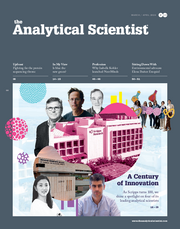Forget Me Not
Poorly understood and rarely emphasized by instrument manufacturers, is a lack of respect for microscopy holding back the microspectroscopy field?
Brooke Kammrath, Dale Purcell | | 4 min read | Opinion


Microscopy is the science – and art – of creating, recording and interpreting magnified images; spectroscopy is the science of qualitatively analyzing the chemical composition of physical and biological matter based on light emission, scattering, and absorption (1). Microspectroscopy (MSP) combines the fundamentals of both – enabling the study of microscopic materials through light–matter interactions (2).
Commercially available microspectroscopy instruments have been sold since the mid-1900s – IR microscopes have been staples in pharmaceutical, forensic, industrial and other scientific laboratories for decades.
The ability to correlate chemical and morphological features of samples is key for many MSP applications; for example, UV-Vis MSP has solved numerous problems in a variety of industries – most notably in investigations involving the dyes and pigments commonly researched in industrial chemistry and forensic science.
The ability to see the sample before spectroscopic analysis is another clear advantage of MSP; for example, analyzing microscopically-sized samples ensures that the target is effectively analyzed. In addition, different microscope contrast techniques (for example, PLM, DIC, Phase Contrast) make different characteristics visible in a sample, which can be used to correlate changes in spectral data with sample microstructure. And when using a microspectrometer, smaller areas of analysis – or spot size – are achievable.
The present
Manufacturers are continually making advances in microspectroscopy, enabling novel research. Some of these advances are small incremental improvements (better optics or lasers, for instance), but there have been other more revolutionary developments in the pairing of microscopy with spectroscopy, such as the recent invention of optical photothermal infrared microspectroscopy + simultaneous Raman (O-PTIR+R) by Photothermal Spectroscopy Corp.
Recent advancements in dichroic mirrors have enabled high throughput spectral analysis and confocality when using different modalities to analyze the same sample. Such advances add new depth to the chemical interrogation of microscopic samples – particularly when using the likes of hyperspectral imaging, particle correlated Raman spectroscopy (PCRS), and morphologically directed Raman spectroscopy (MDRS).
Another trend is the pairing of different techniques with Raman microspectroscopy into instruments capable of simultaneous or tandem analysis on the same sample. Some examples include the combination of FT-IR and Raman microspectroscopy, TERS, AFM-IR, Raman+UV, and Raman+Fluorescence microspectroscopy.
Unfortunately, microscopy, which enables many of the aforementioned benefits and advances in microspectroscopy, is often undervalued. And we’d argue that this lack of respect for the “micro” side of the duo is the biggest challenge facing the field.
One fundamental principle of microscopy that is particularly undervalued in microspectroscopy is the critical importance of sample preparation. There is no post-analysis correction or processing that can overcome poor sample preparation. To achieve optimal MSP analysis, the best microscopic image must be produced. Scientists must put the time and effort into quality sample preparation because the quality of the spectral data is directly correlated with the quality of the image.
Educating individuals about the role, function and importance of good microscopical analysis cannot be underestimated either. It’s also important to know that microscopes are not plug-and-play devices. With a benchtop instrument, optics may be set and not controlled by the analyst – but with MSP, the analyst is responsible for aligning the optics through proper set-up of the microscope. Further, there are a variety of microscopic illumination (transmitted and reflected light) and contrast methods, which could greatly improve the information provided by MSP – if the analyst knew how to use them to produce an image.
All of these aspects appear to be poorly understood in the scientific community – and perhaps worse, they are not highly emphasized by instrument manufacturers.
The future
There are several fields that can benefit tremendously from MSP – from additional applications in forensic science, where it is already established, to new areas, such as pharmaceuticals, cultural studies, and nanomaterials. In pharma, MSP could be used to optimize the identification of small domains in complex drug mixtures and determine the conversion of polymorphic forms to study degradation products and aid the development of novel vaccines and other drugs.
But it is crucial to keep in mind current trends, like artificial intelligence. Such technology will undoubtedly make meaningful advancements in MSP – specifically in areas of hyperspectral imaging, mixture analysis, and spectral interpretation.
As research is continuously expanding, and new questions arise, researchers and manufacturers must work together to ensure these MSP instruments are reaching their potential with regard to both quality images and spectroscopic analysis.
MSP is more than just a concept. It is already established in forensic science and it is ready to expand to other fields – once we put emphasis on the microscopy aspect and understand its role.
Headshot of Brooke - Credit: Lindsey Weinger (Platinum CEM).
Headshot of Dale - Credit: Brent Russell
- JA Reffner, “Microspectroscopy in Forensic Science,” Encyclopedia of Analytical Chemistry. John Wiley & Sons, Ltd: 2017. DOI: doi.org/10.1002/9780470027318.a1117.pub2
- S Walbridge-Jones, “9 - Microspectrophotometry for textile fiber color measurement,” Identification of Textile Fibers, 165. Woodhead Publishing: 2009. DOI: doi.org/10.1533/9781845695651.2.165
Professor of Forensic Science at the University of New Haven and Co-Executive Director of the Henry C. Lee Institute of Forensic Science, Connecticut, USA.
Founder and CEO of Chemical Microscopy LLC, Indiana, USA.

















